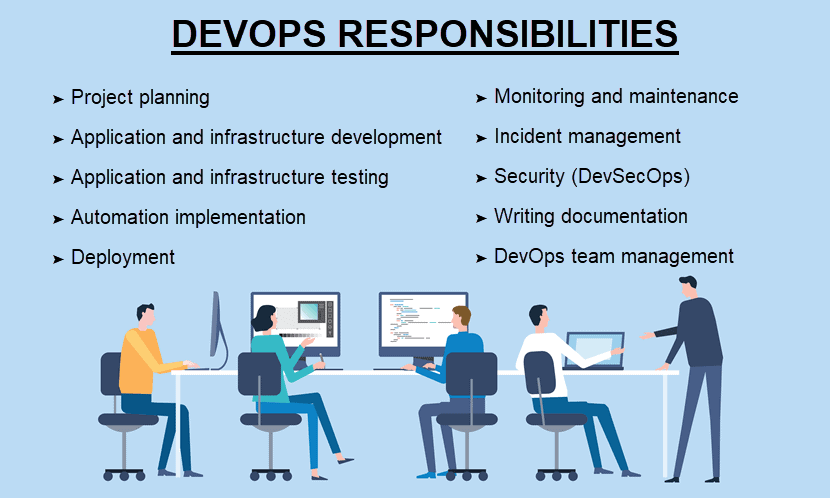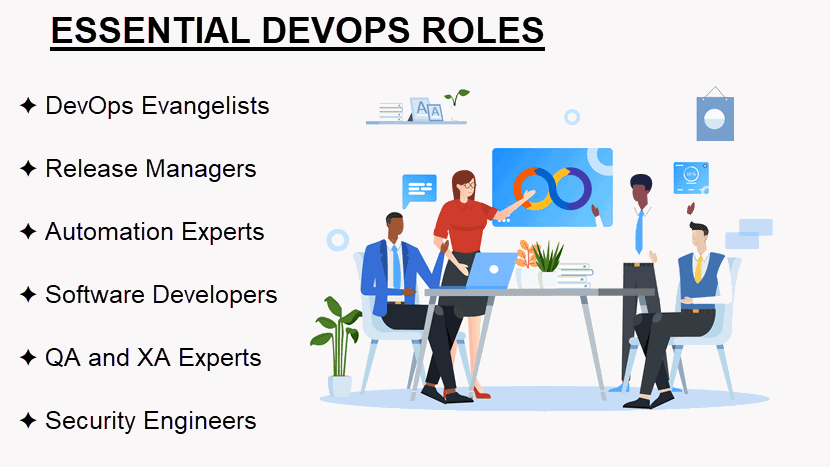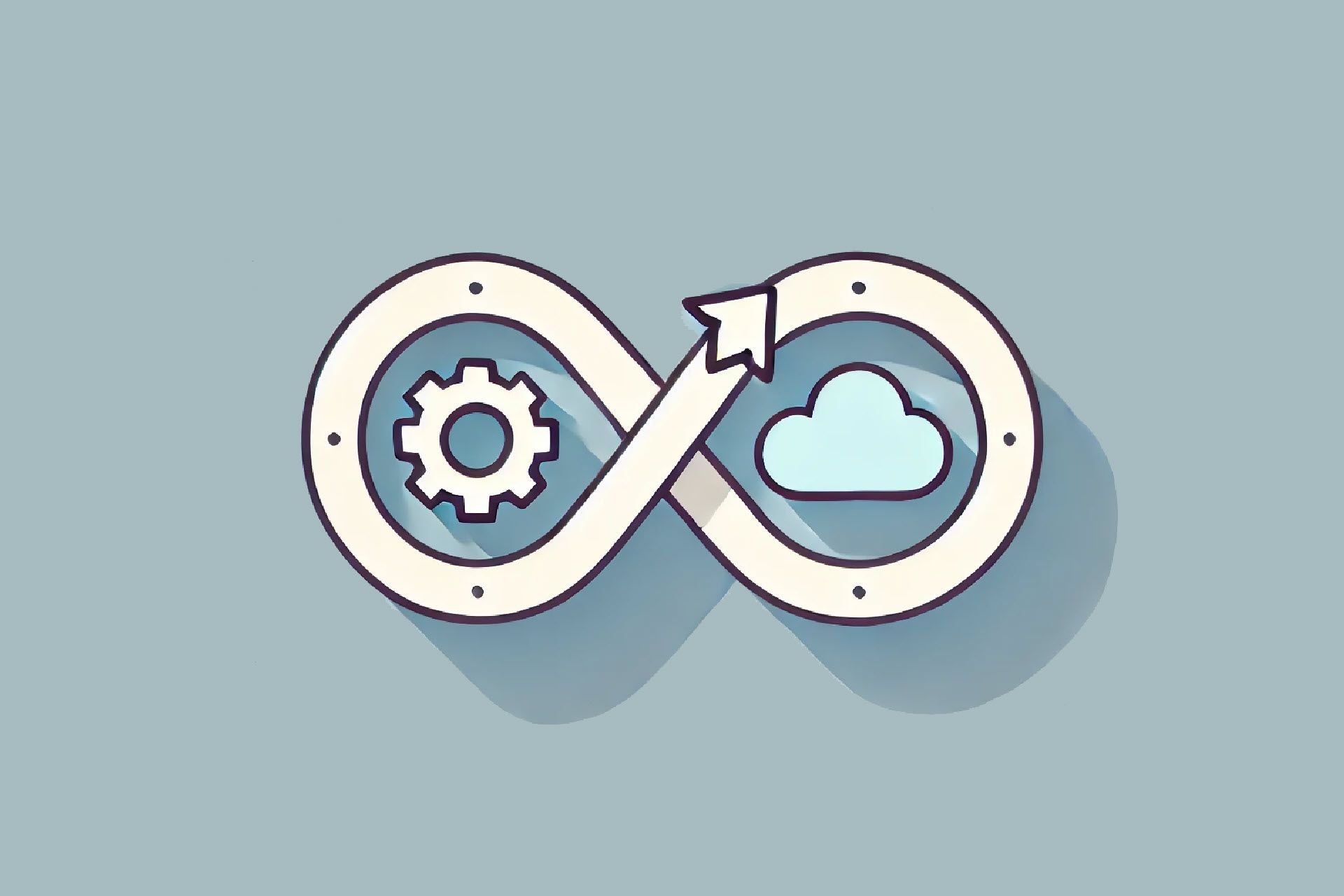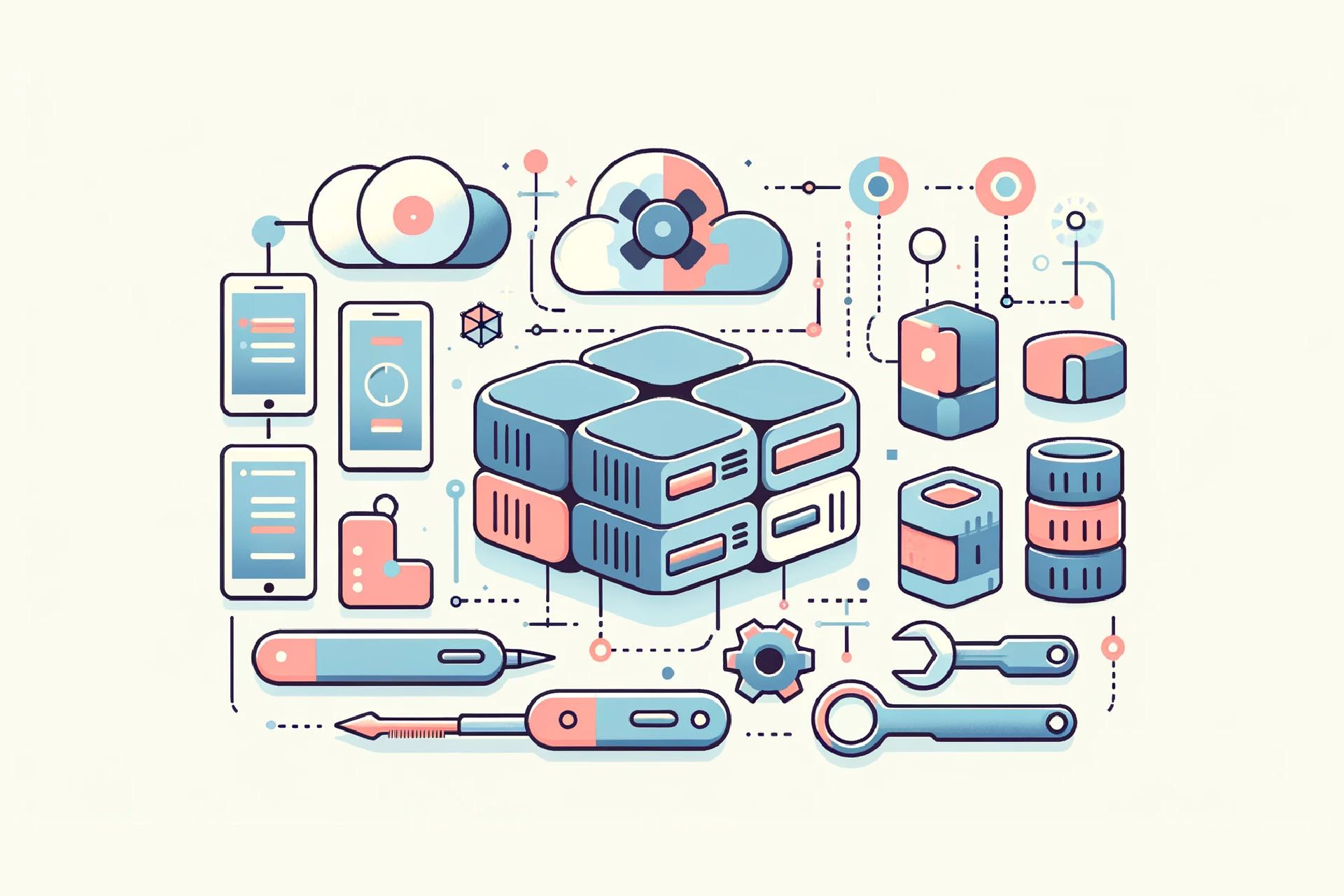DevOps enables companies to accelerate software development and deploy more reliable products. However, DevOps teams are highly dynamic and require staff to account for various tasks and duties.
This article examines the essential DevOps roles and responsibilities. Read on to learn who you need to hire and what you need to account for to create an efficient DevOps team.
What Is a DevOps Engineer?
A DevOps engineer introduces processes, tools, and methods to create an optimal software development lifecycle, from coding and deployment to testing and updates. An engineer’s primary duty is to oversee code releases and deployments.
A DevOps engineer helps overcome the barriers between software development, QA, testing, and IT operations teams. By breaking silos, engineers ensure a collaborative, holistic environment necessary for DevOps.
DevOps engineers work primarily with internal customers, including:
- Software and application developers.
- QC personnel.
- System operators (SysOps).
- Project managers and stakeholders.
A DevOps engineer’s responsibilities include:
- Designing, building, testing, and maintaining the continuous integration and continuous delivery (CI/CD) process.
- Choosing the best tools and technologies the team requires to meet the business needs.
- Automating different phases of the DevOps pipeline.
- Monitoring systems for malicious activity.
- Managing the IT infrastructure.
- Performing on-call service.
- Ensuring system availability.
- Integrating and connecting application elements (APIs, libraries, SDKs, etc.).
Knowledge of scripting, cloud platforms (AWS, Azure, GCP), OS administration, and Git workflows is common among DevOps engineers.
DevOps Responsibilities
Below are the primary responsibilities of a well-rounded, efficient DevOps team.

Project Planning
The staff responsible for DevOps project planning should adopt the agile methodology to keep up with the CI/CD approach. Here are some tips to improve DevOps project planning:
- Split projects up into smaller, interdependent pieces of work.
- Create integrated plans that take into account unplanned work, such as incidents and defects.
- Use feedback from testing, staging, and deployments to re-plan ongoing projects.
Project managers should use the same tools as the software developers. Using the same tooling enables the team to change priorities quickly, set up tracking mechanisms, and keep track of ongoing releases.
Learn the difference between Agile and DevOps, two development methodologies that lead to better products.
Application and Infrastructure Development
The DevOps approach to software development aims for regular, incremental changes to code versions. However, DevOps engineers rarely code from scratch or work directly on product code.
Engineers create solutions, such as scripts or plugins, that save the software developers’ time. These tasks do not require coding skills, but a DevOps engineer typically has mid-to-high scripting ability.
A DevOps engineer is responsible for the configuration and optimization of infrastructure components. Engineers typically use Infrastructure as Code solutions to speed up setup times and ensure more infrastructure flexibility.
Application and Infrastructure Testing
The importance of continuous testing (or shift-left testing) grows as release cycles get shorter. DevOps engineers in charge of tests set up tools, practices, and processes that inspect code early in the pipeline and resolve issues quickly.
The goal of continuous testing is to:
- Increase code quality.
- Create more reliable pipelines.
- Shorten test cycles.
- Keep software defects away from production.
Here are the most common tests DevOps teams run:
- Unit testing: Unit tests get fast feedback on new code. This form of testing focuses on isolated components that are easy to debug and fix.
- Integration testing: Integration tests happen once components merge into the shared pipeline. These tests ensure that the build stays stable with new code additions.
- End-to-end and regression testing: DevOps engineers run these tests by deploying finalized code to different servers and resources. End-to-end and regression tests verify that the application works in a production-like environment.
- Production testing: Production tests run after the application release to check for stability.
Automation Implementation
A DevOps engineer uses automation to make software development consistent, reliable, and efficient. Automation is present at every phase of the software lifecycle, from build triggering and unit testing to packaging and deploying to environments.
Automation allows a DevOps team to quickly and easily:
- Accelerate pipeline processes.
- Scale environments.
- Set up and manage infrastructure.
- Alter CI/CD workflows.
- Run reliable tests.
- Monitor the pipeline.
Automation eliminates repetitive manual assignments. The lack of recurring tasks keeps the staff happy, while pipelines become more stable and efficient.
Monitoring
Monitoring allows an engineer to analyze the performance and stability of applications and infrastructure throughout the software lifecycle. This responsibility consists of several processes:
- Logging: Logging provides teams with data about critical components. Application logs, infrastructure logs, and audit logs help teams learn about and improve products.
- Alerting: Alerting notifies the team and helps engineers stay ahead of issues. Alerts provide debugging information to help solve problems quickly.
- Tracing: Tracing provides performance and behavioral insights that can improve the stability and scalability of apps in production.
Good monitoring is vital for cybersecurity. A reliable monitoring tool makes the difference between a small service interruption and a total outage.
Our article about the different cloud monitoring tools analyzes and compares the best options on the market.
Deployment
Deployment is the act of installing and setting up a version of the software in a target environment. The software version can be:
- Internal release: A release that does not go outside of the development team (e.g., software for QA or demo projects).
- External release: A release for customers and end-users in production.
- Development versions: In-progress code a team deploys for development purposes.
The responsibility of deploying software either belongs to a specific engineer(s), or a team sets up continuous deployment to automate software releases. With CD, every code change passes through automated tests and deploys to production automatically.
Continuous deployment eliminates the need for scheduled releases. The feedback loop is also quicker, so developers can address issues with more agility and accuracy.
Setting up and maintaining automatic deployments is challenging. If the team is not ready to take on this responsibility, the company should first perfect continuous integration and delivery.
Learn the difference between continuous delivery, deployment, and integration, three key DevOps processes.
Maintenance
DevOps engineers perform routine application maintenance across the pipeline. Regular maintenance enables a team to:
- Ensure all environments run smoothly.
- Discover and remove vulnerabilities in the application, infrastructure, or integrations.
- Keep all software up to date.
- Find ways to improve the pipeline.
- Ensure service availability.
Incident Management
Responding and resolving incidents is an essential DevOps responsibility. Incident management keeps the code and infrastructure safe while ensuring the pipeline does not slow down. A typical response strategy has five stages:
- Detection: DevOps engineers set up alert tools and systems to detect anomalies. Most teams have runbooks that inform the staff about the go-to contact in case of an incident.
- Response: A DevOps team typically assigns multiple engineers to be available for escalations. If the on-call team member cannot resolve the problem, the engineer can bring in the right people to assess the impact.
- Resolution: Ideally, DevOps engineers resolve incidents before the problem has a chance to impact the rest of the pipeline.
- Analysis: Whenever a team resolves an issue, engineers analyze the root cause and the response tactic. The goal is to improve system resilience and the team’s ability to detect and respond to incidents.
- Readiness: The team reinforces the system and prevents similar issues from occurring in the future.
Security (DevSecOps)
In traditional setups, security teams operate separately from software developers. This independent approach does not work for DevOps. Rapid development cycles require DevOps engineers to integrate security into the pipeline.
The need for integrated security gave rise to the term DevSecOps. DevSecOps requires a team to:
- Integrate application and infrastructure security into the pipeline with minimal disruption to operations.
- Automate security gates to streamline the DevOps workflow.
- Select the right tools to integrate security continuously.
Read our article about DevSecOps for an in-depth analysis of how built-in security protects the pipeline.
Writing Documentation
Documentation is the primary source of knowledge within a DevOps team. Formal documentation enables engineers to record new features, source code, system requirements, design instructions, bug fixes, tool guides, and response plans.
Good documentation is vital to:
- Incident response plans.
- Software reliability and availability.
- Onboarding new engineers.
- On-call rotations.
- Promoting DevOps best principles.
- Removing silos and tribal knowledge between different departments.
DevOps Team Management
Depending on the size of the team, one DevOps engineer may need to manage other experts. The person in charge of DevOps team management is responsible for:
- Organizing the logistics of an IT project.
- Ensuring all staff is aware of objectives and deadlines.
- Ensuring the staff has real-time visibility across the pipeline.
- Selecting the right CI/CD tools.
Learn more about GitOps, a subset of DevOps.
DevOps Roles
Below are six roles a company must account for to see success from DevOps.

DevOps Evangelist
An evangelist is the change agent who promotes and orchestrates the DevOps culture across an organization. This person is responsible for initiating DevOps adoption and proactively improving the team. An evangelist must:
- Advocate the benefits of DevOps by identifying and quantifying the business impacts.
- Ensure executives, development, and operations departments buy into the DevOps transition.
- Identify the roles to support optimal software delivery.
- Ensure IT staff have sufficient DevOps training.
- Eliminate silos from IT delivery and operations.
- Create integration and orchestration blueprints.
- Select the right DevOps tools for the team.
Transitioning to DevOps requires nurturing a learning culture where teams repeatedly fail, learn from mistakes, and improve. This cycle starts with the DevOps evangelist.
An evangelist is essential at the start of the DevOps journey. Once a company adopts the new way of working, the evangelist continues to find ways to improve the pipeline architecture.
Refer to our post Infrastructure in the Age of DevOps to learn more about the emerging trends and the benefits of adopting DevOps.
Release Manager
Release managers are responsible for the management and coordination of the product from development through production. While similar to project managers, these staff members handle technical details that a traditional PM cannot manage. Release managers must:
- Oversee the coordination, integration, and progress of development, testing, and deployment.
- Support continuous delivery by implementing agile processes.
- Maintain the end-to-end application delivery toolchain.
- Measure and interpret DevOps metrics and KPIs.
Other common names for a release manager are a release engineer or a product stability manager.
Automation Expert
An automation expert is responsible for turning repetitive manual tasks into scripts the team can run on demand. An automation expert must:
- Find automation opportunities across the product lifecycle.
- Select the right processes and tools to automate processes.
- Design scripts the team can use while developing, testing, and monitoring the application.
- Continuously look for ways to speed up development sprints.
- Promote lean thinking across the organization.
Other names for an automation expert are an automation strategist and integration specialist.
Use automation testing tools to streamline and improve your team’s testing processes.
Software Developer
Software developers write product code. However, in a DevOps culture, a developer’s scope of responsibilities expands. A DevOps software developer must:
- Write front-end and back-end code for new releases.
- Launch unit testing.
- Work with QA to ensure the code is bug-free before delivery.
- Monitor the pipeline for issues and potential improvement opportunities.
QA and XA Experts
While software developers are responsible for some testing, a DevOps team still requires a dedicated QA (quality assurance) department. DevOps QA testers are responsible for:
- Testing and verifying releases.
- Documenting bug reports.
- Ensuring features and functions align with design specs.
A strong DevOps testing structure also requires an XA (experience assurance) expert. Whereas QA personnel tests code for functionality, XA staff ensures new features do not negatively affect the end-user experience.
Security Engineer
DevOps security engineers ensure the releases are secure at all stages of the lifecycle. These staff members are responsible for:
- Protecting the pipeline from potential attacks.
- Keeping end-users safe from cyber threats.
- Ensuring the production complies with standards and regulations.
Assemble a Well-Rounded DevOps Team
A successful transition to DevOps is more about people and how they work than it is about technology or tools. Filling in the right roles and responsibilities is the first step to building a productive and efficient DevOps team.



